Abstract
In order to reduce the exhaust noise, which is the main source of gasoline engine noise, this paper uses on orthogonal test to optimize the parameters of the main structure of split-stream rushing muffler (the perforation rate of the perforated pipe, perforation aperture of the perforated pipe, perforation rate of the perforated plate). It also comprehensively evaluates its acoustic and aerodynamic performances to determine the optimal structural model. The acoustic performance and aerodynamic performance of the split-stream rushing muffler and the original muffler are compared and analyzed in the simulation test. The results show that the average Transmission Loss of the split-stream rushing muffler is greater than that of the original muffler, and its Pressure Loss is also lower than that of the original muffler. Through the insertion loss experiment, it was found that the average insertion loss of the main muffling frequency band is 19.14 dB, which is higher than that of the original muffler, and the peak frequency of the insertion loss of the split-stream rushing muffler corresponds well with the peak frequency of the engine exhaust noise. The Pressure Loss of the split-stream rushing muffler was tested on the experiment bench, and the relative error between the experiment data and the simulation data is within 8%. In summary, the split-stream rushing muffler can effectively reduce the exhaust noise problem of gasoline engines.
1. Introduction
With the continuous development and progress of the automobile industry, automobiles account for an increasing proportion of people’s travel choices. By the end of June 2024, the total number of motor vehicles in China had reached 440 million, of which automobiles accounted for 345 million, representing 78% of the total number of motor vehicles. The increase in the number of automobiles provides people with greater convenience for traveling but also introduces new challenges; that is, the increase in the number of automobiles contributes to environmental pollution. Among these issues, the noise pollution caused by automobiles is particularly serious. Automobile noise can be classified according to the source, mainly including engine noise, transmission system noise, intake and exhaust system noise, tire noise, braking system noise, and wind noise. The impact of vehicle noise is primarily manifested in four aspects. (1) Human health: long-term exposure to noise can potentially damage hearing and cause severe harm to the nervous system, cardiovascular system, and audiovisual function. Prolonged exposure to high levels of vehicle noise may lead to irreversible hearing impairment, and it can also disrupt normal physiological functions, triggering stress responses in the body. This might result in elevated blood pressure, an increased heart rate, and various cardiovascular disorders. Additionally, it can affect cognitive functions, cause sleep disturbances, and lead to psychological problems such as anxiety and irritability, thereby impacting the overall well-being of individuals. (2) Ecosystem: noise can significantly interfere with wildlife behavior, altering their natural routines and patterns. It can disrupt the communication, foraging, mating, and migration processes of wild animals. Moreover, it may have a negative impact on the endocrine and immune systems of wildlife, thereby reducing their reproductive success and survival rates. Some species may be forced to change their habitats or migration routes due to noise pollution, which could disrupt the ecological balance in the long term. (3) Urban acoustic environment: vehicle noise is a major source of urban noise pollution, which severely degrades the acoustic environment of cities. It creates a noisy and unpleasant atmosphere, exceeding acceptable noise levels in residential, educational, and commercial areas, thus significantly affecting residents’ daily activities, including rest, study, and recreational pursuits. The continuous presence of vehicle noise can diminish the quality of life in urban areas and affect the overall comfort and tranquility of the living environment. (4) Buildings and facilities: in certain situations, especially on high-traffic, high-speed, and high-noise road sections, the vibration generated by vehicle noise can affect nearby buildings. Over time, this vibration may lead to the loosening of structural components, such as causing cracks in walls and compromising the stability and safety of buildings. Although the immediate impact may not be drastic, the cumulative effect of long-term exposure to such vibrations could pose risks to the structural integrity of buildings.
The negative impact of vehicle noise spans across human, ecological, urban, and architectural domains. Consequently, its control and management play a crucial role in environmental protection and urban development [1,2,3].
Among these sources, engine noise is the most important source of noise in automobiles. The emission noise of the engine exhaust system without exhaust muffler treatment is the main source of engine noise, so it is crucial to design a muffler with excellent muffling performance.
Regarding the calculation and analysis of the acoustic characteristics of the muffler and intake and exhaust systems, plane wave theory was proposed as the earliest method to calculate the acoustic characteristics of the muffler. When the frequency of the noise is lower than the first higher-order mode excitation frequency of the muffler (i.e., the plane wave cutoff frequency), the sound wave propagates inside the muffler in the form of a plane wave. Therefore, plane wave theory can be used to calculate the acoustic properties of the muffler. The application of the transfer matrix method provides a brand-new solution for the calculation of the acoustic performance of mufflers. Davis et al. conducted a systematic and comprehensive study in 1954 and discussed the acoustic characteristics of mufflers with different structures under the condition of no airflow, including a single-stage expansion chamber muffler, a multi-stage expansion chamber muffler, and a side-branch resonator [4]. However, plane wave theory still has some limitations in analyzing practical problems. Plane wave theory can be applied when the noise frequency is lower than the first higher-order mode excitation frequency of the muffler. Under these conditions, plane wave theory can be used to calculate the acoustic performance of the muffler. However, in practice, the noise frequency is often very high, exceeding the plane wave cutoff frequency, resulting in higher-order modal waves inside the muffler. At this time, the sound field inside the muffler is three-dimensional, so plane wave theory cannot be applied to predict the internal sound field of the muffler. Faced with such a problem, a solution is quickly found. The three-dimensional analytical method is an effective means of establishing a three-dimensional sound field simulation for a muffler with regular geometry. In order to calculate and analyze the multidimensional wave effect, many scholars have proposed different muffler design methods, including the modal expansion method, the matching point method, and the mode matching method. These methods are widely used in muffler design. In the actual situation, the structure inside the muffler is complex and variable and not symmetrical, so scholars proposed the use of the finite element method, a numerical calculation method, to calculate and analyze those mufflers with complex structural forms. In the 1970s, Ji et al. introduced the finite element method for the first time in the muffler acoustic characteristic analysis and calculation. With the gradual improvement of the acoustic calculation theory, more and more scholars invested in research on muffler acoustic performance [5]. Pravin P. Hujare et al. pointed out that the acoustic performance of a reactive muffler is greatly affected by the number of holes in the inlet and outlet pipes, as well as their positions at the target frequency [6]. Chen Key et al. addressed the issue of difficult suppression of low-frequency noise in pipelines and designed a composite broadband muffler by using a combination of a pair of Helmholtz resonance cavity array acoustic panels and a perforated pipe muffler, achieving low-frequency broadband high muffling [7].
Scholars have studied how to make the muffler’s acoustic performance reach an ideal state while also noticing a performance index that is equally important for mufflers: exhaust back pressure. Exhaust back pressure refers to the change in the air pressure at the exhaust valve before and after the engine is connected to the exhaust system. Nandkumar Patil used CFD software to find the location of the exhaust back pressure in the exhaust system, providing the basis for the subsequent optimization of the exhaust back pressure of diesel engines [8]. Zhengming Wang used GT-power to optimize the internal structure of the muffler of a formula car. The internal structure of the muffler of a formula racing car was optimized by using GT-power, reducing the exhaust noise by 20% while preserving the dynamics of the car [9]. Peng Changqing et al. used CATIA to create a three-dimensional model of the muffler, simulated its Transmission Loss by using Virtual. Lab 12 acoustic simulation software, and finally improved the muffler to meet the requirements of exhaust back pressure [10].
In summary, the acoustic performance and aerodynamic performance of mufflers are the main indexes for evaluating mufflers, and the discussions and research on these two indexes are mainly centered on basic theories and structural influencing factors. Therefore, the research on parameter optimization of the complex structure of multi-cavity mufflers is still lacking. Aiming to address the existing problems, the muffler based on the principle of shunt gas hedge muffling is a new research object, and the optimization of multi-structure parameters of the coupled muffler is a useful attempt to improve the performance of the muffler.
At present, the noise frequency of a gasoline engine was mainly concentrated in the low and medium frequency regions, and there was a small amount of high-frequency noise distribution. High-frequency noise was more hazardous to health, and it was more difficult for the human ear to endure. The traditional gasoline engine muffler usually adopted an impedance composite structure. Among them, the resistive muffler was excellent in controlling medium and high frequency noise. The muffling principle involved using fiber or porous acoustic material placed above the airflow channel. When the sound wave passed through the porous acoustic material, under the effect of friction and damping, the sound wave was converted into thermal energy, so as to achieve the purpose of muffling. However, one of the obvious disadvantages of sound-absorbing materials was their short service life, they were easily affected by high-temperature oxidation, high-speed airflow impact, and water vapor infiltration, which led to the failure of sound-absorbing materials, thus causing frequent maintenance of the muffler, poor effect, and short service life, etc. The reactive muffler was produced through the use of fiber or porous sound-absorbing materials. The reactive muffler was a muffler that produced sound energy reflection and interference caused by impedance change in the process of sound propagation through the mutation of pipeline cross-section or side-branch resonance cavity, thus reducing the sound energy radiated outward by the muffler to achieve the purpose of muffling sound. The split-stream rushing muffler belonged to the reactive muffler, and the split-stream rushing muffler structure could reduce the speed of the gas flow inside the muffler, so as to improve its acoustic and aerodynamic performance. After experiment verification, the split-stream rushing muffler structure had certain low-frequency and medium-frequency muffling effects, and it had obvious advantages for the suppression of high frequency noise [11,12,13,14]. Therefore, the scheme of the split-stream rushing muffler structure coupled with the traditional reactive muffler structure was a brand-new idea to solve the exhaust noise problem of gasoline engine, while also verifying the applicability of the split-stream rushing muffler on different engines. On the basis of this group’s previous research, the KTM690 single-cylinder gasoline engine used in formula racing was selected as a test prototype, and a split-stream rushing muffler suitable for single-cylinder gasoline engines was designed, which ultimately achieved good muffling performance and low exhaust backpressure.
2. Materials and Methods
The performance evaluation index of the muffler is of great significance for optimizing muffler design and improving noise control effect. In this paper, the acoustic performance evaluation index and aerodynamic performance evaluation index of the muffler will be discussed in depth. The acoustic performance evaluation index was used to measure the muffler’s ability to weaken the sound, while the aerodynamic performance evaluation index reflected the muffler’s resistance to airflow and its influence on the air volume and air pressure.
2.1. Evaluation Index
2.1.1. Acoustic Performance Evaluation Index
In this paper, the main evaluation indexes of acoustic performance used in the design of split-stream rushing muffler are Transmission Loss and insertion loss.
- 1.
- Transmission Loss
Transmission Loss is defined as the difference between the incident sound power level at the inlet of the muffler and the transmitted sound power level at the outlet when there is no reflective end at the outlet and when there is a one-dimensional plane wave in the channel [15], expressed as
where Wi and Wt are the incident sound power at the muffler inlet and the transmitted sound power at the outlet, respectively. Since the Transmission Loss is only related to the muffler itself, independent of the impedance of the sound source and the radiation impedance of the orifice, it is widely used for simulation in the early stage of muffler design. However, when conducting muffler Transmission Loss experiments, it is necessary to accurately measure the incident sound pressure and transmitted sound pressure inside the pipe, but these two values are often difficult to measure. Therefore, it is typically not possible to measure the muffler’s Transmission Loss during testing. Moreover, the Transmission Loss is more suited for evaluating of the acoustic performance of an ideal muffler under ideal conditions and is not practical compared to the insertion loss of a real vehicle.
- 2.
- Insertion loss
The insertion loss is the difference between the sound power level of the noise radiated from the orifice before and after the installation of the muffler. When the sound field distribution is kept approximately constant during the test, the insertion loss is the difference between the sound pressure level before and after the installation of the muffler at a given measurement point [16].
IL = Lp′ − Lp = 20lg|P′/P|
Given that the acoustic radiation impedance at the outlet of the piping system remains essentially unchanged before and after the installation of the muffler, the insertion loss can accordingly be expressed as
where P′2 and P2 are the sound pressure at the outlet of the piping system before and after the installation of the muffler, respectively. The noise source, the muffler, the pipeline, the pipe outlet, and the surrounding environment will affect the insertion loss to different degrees, so the insertion loss is not only an attribute of the muffler alone but also an attribute of the whole system. Therefore, the insertion loss can often be a more realistic response to the muffling performance of the muffler. However, because the muffler needs to simulate the evaluation indexes of the muffler in the pre-design process, the insertion loss is obviously not an evaluation index that can be well simulated, so the insertion loss is not taken as the simulation object in the simulation stage. Mostly, the muffler insertion loss test is carried out in the final physical experiment stage.
IL = 20lg|P′2/P2|
2.1.2. Aerodynamic Performance Evaluation Index
If the aerodynamic performance of a muffler fails to meet the expected standards, it will cause a series of problems, such as increased fuel consumption, poor vehicle dynamics, and excessive exhaust back pressure. Tracing back to the origin, the Pressure Loss of the muffler mainly consists of two components: the Pressure Loss caused by the friction between the wall surface of the channel inside the muffler and the airflow (friction resistance) and the Pressure Loss caused by the impedance effect of the change of the internal structure of the muffler on the airflow (local resistance).
- Friction resistance loss
The frictional drag loss is due to the viscous force of the fluid [14], and the frictional drag loss is calculated as follows:
where ΔPλ—friction resistance loss; λ—friction resistance coefficient; L—pipe length; d—muffler pipe diameter; ρ—gas density; V—gas flow velocity.
- Local resistance loss
Local resistance is described as the energy loss that occurs in a flow, where the flow state changes drastically [17]. The local resistance loss in a pipe is expressed as
where ΔPξ—local resistance loss; ξ—local resistance coefficient; ρ—gas density; V—gas flow velocity. Among them, the Pressure Loss of the muffler is mainly composed of local resistance loss and friction resistance loss.
2.2. Working Principle of Split-Stream Rushing Muffler
According to different classification principles, mufflers could be categorized into three types: reactive mufflers, dissipative mufflers, and impedance mufflers. Among them, the muffling effect of the dissipative muffler depends on the sound-absorbing effect of the sound-absorbing material on the sound wave. The reactive muffler often relies on its internal structure to make the sound wave reflect and interfere in the propagation process. Reactive mufflers consist of different types of units, such as expansion chambers, resonance chambers, and so on. Figure 1 shows a reactive muffler. Impedance mufflers use a combination of resistant muffling units and sound-absorbing materials to achieve muffling.

Figure 1.
Reactive muffler.
Under the premise of satisfying good noise suppression and low air flow resistance, the development of a muffler with excellent noise suppression effects has become the focus in the field of mufflers. To address this issue, a brand-new split-stream counteracting muffler unit was proposed by the Inner Mongolia Agricultural University, College of Electrical and Mechanical Engineering for the first time. The muffler unit was divided into the inner cavity and the outer cavity. The airflow from the inlet entered the outer cavity and encountered the front end of the conical structure where separation occurred. Then it passed through the rushing holes into the inner cavity. The two opposing directions and the same speed of the airflow occurred after the hedging. The airflow speed was greatly reduced, which improved the performance of the muffler [18]. The structure of the muffler is shown in Figure 2.
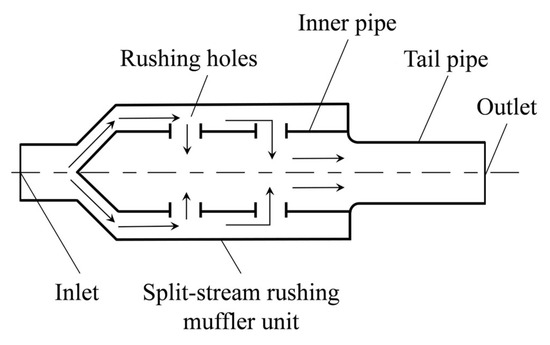
Figure 2.
Split-stream rushing muffler unit.
The structure has excellent mid-frequency and high-frequency anechoic performance, while the design of the frequency can effectively reduce the gas flow rate, thus suppressing the airflow regeneration noise.
2.3. Acoustic and Aerodynamic Tests
2.3.1. Gasoline Engine Noise Test and Acoustic Test
In this paper, the model of the gasoline engine is KTM690, which features light weight, high power, and a high rotational speed. Table 1 shows the technical parameters of the KTM690 engine [19].

Table 1.
Technical parameters of the ktm690 engine.
According to the requirements of GB/T 33928-2017 [20] “Measurement Methods for Internal Combustion Engine Exhaust Mufflers”, the exhaust noise characteristics of the target gasoline engine were tested. The exhaust noise testing steps were as follows (similar to the muffler insertion loss test steps):
- (1)
- After removing the muffler of the target engine, the engine was placed in an open area, and it was ensured that there were no reflectors around the site to reduce inaccurate test results due to sound wave reflection.
- (2)
- A straight pipe was connected directly to the engine exhaust. The length of the straight pipe was the same as that of the previous muffler. In order to minimize the influence of other engine noises on the exhaust noise, a whole sound insulation panel with an opening in the middle was used. The straight pipe was passed through the opening and extended out of the sound insulation panel, and the opening of the sound insulation panel was sealed for sound and vibration isolation.
- (3)
- The engine was placed outdoors, and it was ensured that there was no interference from other noise sources. When the outdoor wind speed was greater than 1 m/s, a wind shield was used as required to reduce the impact on noise testing due to excessive wind speed; when the wind speed exceeded 5 m/s, the measurement was stopped to avoid distorted test data, and there were no reflectors within 10 m around the exhaust pipe.
- (4)
- The measurement position was located at a 45° direction of the exhaust port airflow axis, and the measuring distance was selected as 1 m, with one measuring point taken. When measuring the distance, it was ensured that the measuring distance was greater than three times the diameter of the pipe opening and not less than 0.25 m.
- (5)
- After the preliminary arrangement work of the test was completed, the engine was started. After the engine had run for 10 min, a sound level meter was used to measure the exhaust noise of the engine at different speeds, namely idle speed, medium speed, and rated speed. During the test, two data measurements were completed, respectively, and the average value of the two data measurements was taken. In one test, two data records were completed, and the parking time interval between the two data records did not exceed 30 min. The test schematic diagram is shown in Figure 3, and the test equipment is shown in Figure 4. The test equipment used in this test was the B&K 2250 sound level meter and the 4231 type calibrator.
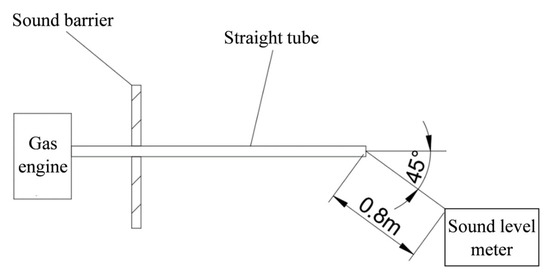 Figure 3. Schematic diagram of engine exhaust noise test.
Figure 3. Schematic diagram of engine exhaust noise test.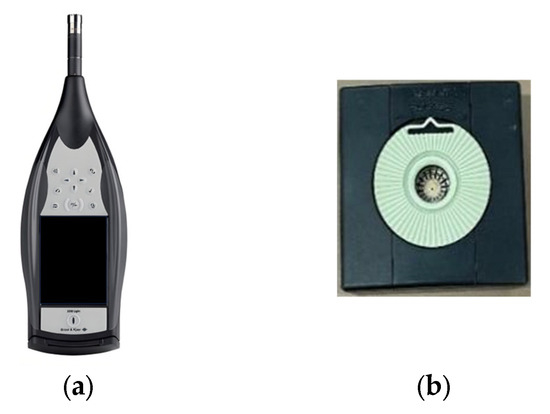 Figure 4. Test equipment: (a) B&K 2250 sound level meter; (b) type 4231 calibrator.
Figure 4. Test equipment: (a) B&K 2250 sound level meter; (b) type 4231 calibrator.
After the engine exhaust noise test was completed, noise spectrum analysis was carried out using the noise characteristic analysis software Noise Partner 1.9 provided by B&K (Hottinger Brüel & Kjaer GmbH., Darmstadt, Germany). Data analysis was performed at an idle speed of 1500 r/min, a medium speed of 3000 r/min, and a rated speed of 5000 r/min, respectively. The results are shown in Figure 5.
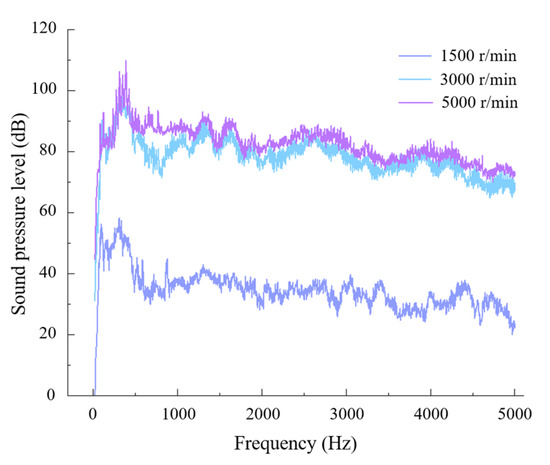
Figure 5.
KTM690 single-cylinder gasoline engine noise spectrogram.
Since the target gasoline engine was a racing engine, the engine was kept at the rated speed for most of the time during the race, so the center of gravity of noise reduction was placed at the rated speed. In the whole frequency band of the rated speed, the peak frequency of the engine exhaust noise was 381 Hz, and the noise reached 110 dB. Meanwhile, in the frequency range near 381 Hz, the noise energy distribution was obvious, being around 100 dB; moreover, in the frequency range between 500 Hz and 1000 Hz, the noise energy was around 90 dB, and the noise of 90 dB had seriously affected people’s daily life, so this frequency band was also taken as the center of the noise reduction. In addition, in the frequency range of 500~1000 Hz, the noise energy was around 90 dB, a level that seriously affected people’s daily life. As a result, this frequency band was also regarded as the key anechoic band; for the frequency range after 1000 Hz, as shown in the figure, although individual noise peaks reached more than 90 dB, the overall noise energy was not high. Therefore, this band was not regarded as the main target band for anechoic noise reduction. To summarize, the target anechoic frequency was determined as 300~1000 Hz.
2.3.2. Aerodynamic Tests
In order to analyze the errors between the Pressure Loss value and the outlet velocity value of the split-flow counteracting muffler and their respective simulated values, the Pressure Loss and the outlet velocity of the acrylic model of the split-flow counteracting muffler were tested using the self-made muffler Pressure Loss test bench developed by the research group in the earlier stage. The equipment required for the test comprised a 565-P multifunctional air volume meter, a hot-wire anemometer probe, and a blower. Figure 6 showed the Pressure Loss test bench, and Figure 7 showed the equipment required for pressure loss testing
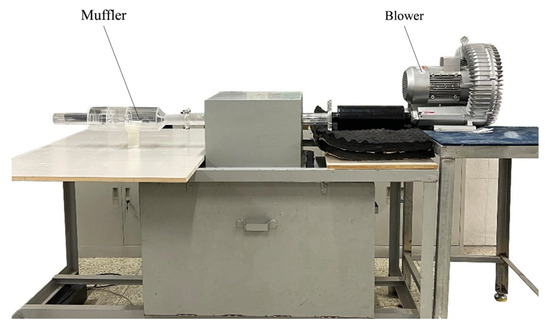
Figure 6.
Pressure Loss test bench.
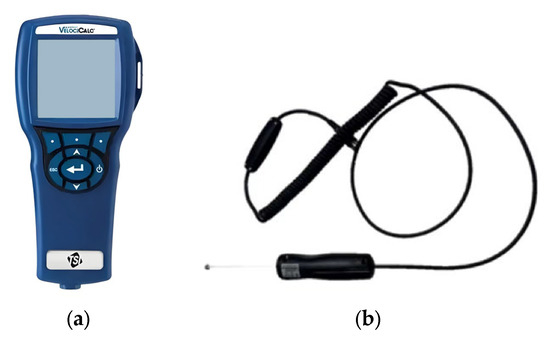
Figure 7.
Test equipment: (a) 565-P multifunctional air volume meter; (b) hot-wire anemometer probe.
2.4. Structural Coupling of a Split-Stream Rushing Muffler
According to the main muffling frequency band of 300 Hz to 1000 Hz derived from the exhaust noise test, it was decided to design a split-stream rushing muffler with excellent muffling and noise reduction performance and small Pressure Loss by using a new type of split-stream gas hedge muffler unit coupled with the traditional expansion cavity and perforated pipe structure. In order to better understand the overall performance of the split-stream rushing muffler, without changing the volume of the muffler (the volume of the split-stream rushing muffler was the same as that of the original muffler), the muffler was divided into two parts: the split-stream rushing muffler unit and the traditional reactive muffler unit. Previous research found that when the new split-stream rushing muffler is coupled with other muffler units, the performance indexes are optimal when the ratio of the structure size is 1:1. Therefore, the dimensions of the split-stream rushing muffler and the reactive muffler unit in the split-stream hedging muffler were each 275 mm. The total length of the muffler was 550 mm, and the diameter was 188 mm.
For the reactive muffler unit in the rear section of the muffler, the increase in the number of chambers could effectively improve the acoustic performance, so the reactive muffler unit in the rear section was designed as a three-chamber structure. Since high-frequency noise is harmful to people, in addition to the main muffling frequency band, the split-stream rushing muffler needed to account for some high-frequency noise suppression, so the chamber was interspersed with some perforated pipes and perforated plates to enhance the muffler’s high-frequency noise suppression capability. The specific structural parameters of the perforated pipe and perforated plate will be discussed and studied in detail in the simulation optimization section of Chapter III. The structure of the shunt hedge muffler is shown in Figure 8.
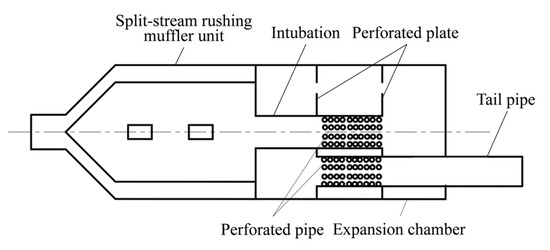
Figure 8.
Structure diagram of split-stream rushing muffler.
2.5. Scheme of Orthogonal Tests
In order to determine the final structural size parameters of the split-stream rushing muffler, simulations of models with different structural sizes were required to pick the optimal model. The method used to select the optimal model in this article was orthogonal testing. Orthogonal test design is a reliable multi-factor test design method based on scientific research verification. It uses orthogonal tables to achieve efficient and reliable results by systematically arranging and analyzing tests. Orthogonal experimental design is one of the most widely used experimental design methods [21].
The split-stream rushing muffler was divided into two parts in total in terms of composition: the front section is the split-stream rushing muffler unit, whereas the rear section is the traditional reactive muffler unit. Building on the group’s previous detailed research, this orthogonal test focused only on the back section of the reactive muffler units of some important structural dimensions to study, discuss, and select the structure that had the greatest impact on the acoustic performance and aerodynamic performance as a factor. A three-factor, three-level orthogonal test with the perforation aperture of the perforated pipe (A), the perforation rate of the perforated pipe (B), and the perforation rate of the perforated plate (C) as the test factors and Transmission Loss and Pressure Loss as the test indexes was established.
According to the principle of orthogonal test design, using the standard orthogonal test table L9 (33), a total of nine simulation test groups were designed, with three repetitions of the simulation analysis, and the average value of each group of tests was used as the test results. The test scheme was shown in Table 2.

Table 2.
Factors and levels of orthogonal tests.
For the selection of the level in each factor, it was found that when the perforation rate of the muffler unit was too low, the Pressure Loss increased significantly. Because the perforation rate was too small, the actual passing area of the airflow was much smaller than the cross-sectional area, and the circulation of the airflow was subjected to excessive resistance; therefore, the Pressure Loss became larger. If the perforation rate was too high, the plate or the tube provided limited obstruction to the airflow, and the muffling performance did not change significantly. In this case, the muffler with the perforated unit could be equivalent to an ordinary expansive muffler; therefore, it should be selected in the appropriate range. The muffler with a perforated unit could be equated to an ordinary expansive muffler, so the perforation rate should be selected within a suitable range [22]. After reviewing the literature, it was finally decided to use the perforation rates of 5%, 10%, and 15% for the perforated pipe, 7%, 9%, and 15% for the perforated plate, and the perforation aperture of 6 mm, 8 mm, and 10 mm for the perforated pipe as the factor levels for this orthogonal test.
3. Results
3.1. Subsection
Since the muffler design needed to account for both performance indicators, the combined scoring method was used as the result analysis method in the orthogonal test [23]. The scoring formula of the comprehensive scoring method is as follows:
where Aij is the weighting of indicators; Xij represents the indicators of the test; i denotes the test number i; j denotes the indicator number j. The orthogonal test totaled two evaluation indexes, i.e., Transmission Loss and Pressure Loss, and since the muffler was designed with acoustic performance as the main consideration, the Transmission Loss accounted for 0.7 and the Pressure Loss accounted for 0.3. In order to more intuitively represent the comprehensive score of the split-stream rushing muffler, the summing operation was carried out on the Transmission Loss of the main muffling frequency bands (300 Hz to 1000 Hz), which was used as the acoustic performance evaluation index. In addition, it should be noted that the value of the Transmission Loss had to be as large as possible; on the contrary, the value of the Pressure Loss had to be as small as possible, so the Pressure Loss term was set as a negative term [24]. Table 3 shows the results of orthogonal tests.

Table 3.
Table of orthogonal test results.
From the table of orthogonal test results, it can be seen that the best score among the nine models was achieved by model No. 5, with a Transmission Loss of 2932.67 dB, a Pressure Loss of 4525.41 Pa, and a comprehensive score of 695.25. Moreover, the structural parameters of No. 5 (perforated pipe perforation aperture diameter of 8 mm, perforated pipe perforation rate of 10%, and perforation rate of the perforated plate perforation rate of 15%) were the same as the optimal parameter combinations. From the table, it can also be seen that the factors that had a greater impact on the overall performance of the split-stream rushing muffler were perforated plate perforation rate > perforated pipe perforation aperture > perforated pipe perforation rate, respectively, in descending order of influence.
After the optimal model structural parameters were derived from the orthogonal tests, the model was analyzed in detail for acoustic and aerodynamic performance, including Transmission Loss, velocity field, pressure field, and turbulent kinetic energy field.
3.2. Acoustic Performance Analysis of Split-Stream Rushing Muffler
3.2.1. Acoustic Performance Simulation Test Results and Analysis
The simulation software used in this paper was LMS Virtual. Lab 13.6, which mainly adopted two methods: the acoustic finite element method and the acoustic boundary element method, as part of the acoustic numerical calculation approach. The acoustic finite element method was used to simulate the Transmission Loss of the split-stream rushing muffler.
The acoustic mesh of the split-stream rushing muffler was drawn using Hypermesh, and the number of tetrahedral meshes totaled 811,777. The acoustic mesh schematic is shown in Figure 9.

Figure 9.
Acoustic mesh of split-stream rushing muffler. (a) Overall diagram of acoustic mesh; (b) internal diagram of the acoustic mesh.
The mesh file, which had been drawn into the software, was imported, and the Acoustic Finite Element module was opened. Next, the imported mesh was redefined as an acoustic mesh, and the fluid properties of the mesh were set to air. The air density was set to 1.293 kg/m3. The inlet and the outlet were defined, and then the acoustic boundary conditions were set, with the inlet set to the plate velocity and the outlet using Automatic Matched Layer boundary conditions. Finally, the solution setup was performed, with the solution frequency of 1–5000 Hz and the interval of 10 Hz. Figure 10 shows the interface for calculating the Transmission Loss.
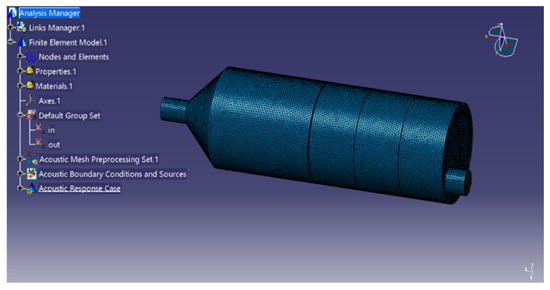
Figure 10.
The interface for calculating the Transmission Loss.
Figure 11 presents the comparison of the Transmission Loss between the split-stream rushing muffler and the original muffler. Based on the Transmission Loss comparison graph, it was observed that within the main muffling frequency range from 300 Hz to 1000 Hz, the split-stream rushing muffler exhibited a peak Transmission Loss value of 110 dB, whereas the peak Transmission Loss of the original muffler was merely 45 dB at that time. Simultaneously, in this frequency band, the average Transmission Loss of the split-stream rushing muffler was 41.91 dB, and that of the original muffler was 34.13 dB. Evidently, the average Transmission Loss of the split-stream rushing muffler surpassed that of the original muffler. Secondly, upon aggregating the Transmission Losses within the main muffling frequency bands, it could be deduced that the Transmission Loss of the split-stream rushing muffler was 22.9% higher than that of the original muffler. In addition to the discussion and analysis of the Transmission Loss within the main muffling frequency bands, it was also essential to take into account the high-frequency noise suppression capacity of the split-stream rushing muffler. In the high-frequency noise region beyond 1000 Hz, with the exception of a few isolated frequencies and frequency bands where the Transmission Loss of the original muffler was greater than that of the split-stream rushing muffler, the Transmission Loss of the split-stream rushing muffler was considerably larger than that of the original muffler in the majority of the other frequency bands. Thus, it was apparent that the split-stream rushing muffler also possessed a certain degree of high-frequency noise suppression ability.

Figure 11.
Comparison of the Transmission Loss between the split-stream rushing muffler and the original muffler.
In summary, whether considering the full frequency band noise suppression effect or the 300~1000 Hz key muffling area, the split-stream rushing muffler met the acoustic performance design requirements, and the acoustic performance was better than that of the original muffler.
3.2.2. Acoustic Performance Experiment Results and Analysis
The split-stream rushing muffler was tested for insertion loss using a formula race car equipped with a KTM690 single-cylinder gasoline engine (KTM, Mattighofen, Austria) as a prototype. The equipment used for the experiment was a B&K2250 sound level meter (Hottinger Brüel & Kjaer GmbH., Darmstadt, Germany), a calibrator type 4231, and a sound barrier. Figure 12 shows the physical diagram of the split-stream rushing muffler, while Figure 13 shows the experimental diagram of the exhaust noise of the split-stream rushing muffler.
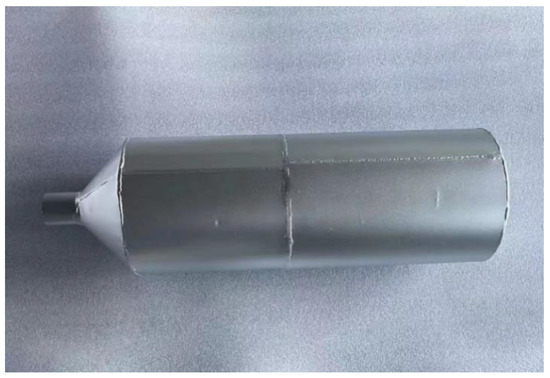
Figure 12.
Physical model of split-stream rushing muffler.
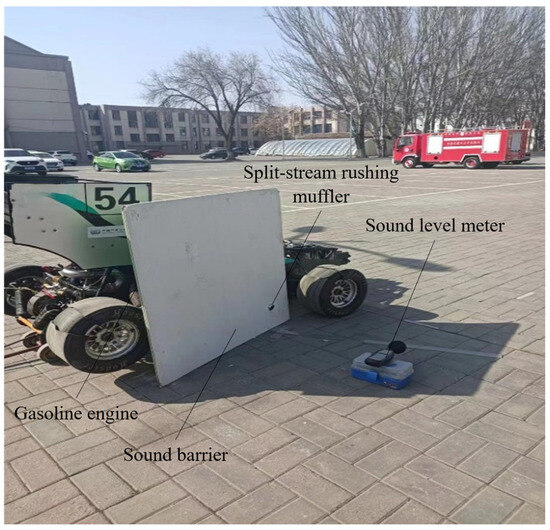
Figure 13.
Noise experiment of the split-stream rushing muffler.
Figure 14 presents the insertion loss at 5000 r/min. It was observed that the insertion loss across the entire frequency band at this particular speed was relatively high. Specifically, the peak insertion loss, which occurred at 381 Hz, reached a value of 39.74 dB. Although negative insertion loss was present at certain individual frequencies, the magnitudes were minimal and thus exerted little influence on the overall muffling and noise reduction efficacy of the muffler. With regard to the target anechoic band (ranging from 300 Hz to 1000 Hz), the average insertion loss was determined to be 19.14 dB. The correlation between the peak frequency of the noise within the target anechoic band (381 Hz) and the frequency corresponding to the peak of the insertion loss at the rated speed was highly favorable, with the insertion loss attaining a level of 40 dB. It could also be observed from the insertion loss graph that the overall suppression effect of the muffler on high-frequency noise was quite remarkable, with the insertion loss reaching a maximum of 30 dB, which was consistent with the expectations during the initial design phase.
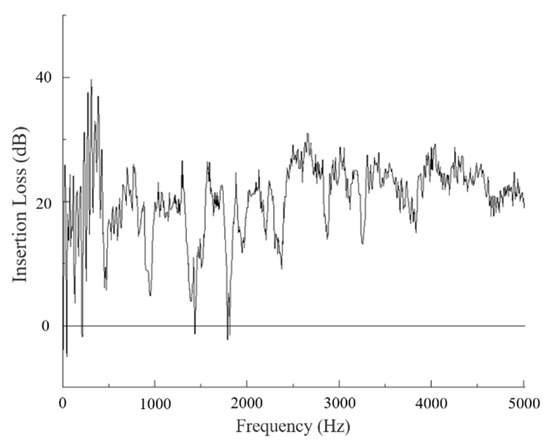
Figure 14.
A 5000 r/min insertion loss diagram.
3.3. Aerodynamic Performance Analysis of Split-Stream Rushing Muffler
3.3.1. Aerodynamic Performance Simulation Test Results and Analysis
The computational fluid dynamics software used in this paper was Fluent, and Fluent’s flow field calculation method was the finite volume method. The main features of the finite volume method were small memory, fast computing speed, easy-to-use high-order format, and high accuracy.
Fluid meshing was performed using Hypermesh 2019, with a mesh size of 4 mm and a total of 3,335,035. The fluid mesh is shown in Figure 15.

Figure 15.
Fluid mesh of split-stream rushing muffler. (a) Overall diagram of fluid mesh; (b) internal diagram of the fluid mesh.
First, Fluent 2021R1 software was opened, and the pre-drawn mesh file was imported into it. The mesh quality was then checked to ensure it met the requirements of the simulation calculations, and the units within the software were made consistent with those of the model. In the Models option, the viscous option was enabled, and the K-epsilon model was chosen. Subsequently, the properties of the fluid were set. The fluid in the muffler was air, with the density set to 1.293 kg/m3. The boundary conditions of the muffler were selected, where the inlet was designated as the velocity-inlet type (Velocity-Inlet), and the inlet velocity was set to 40 m/s, while the outlet was chosen as the pressure-outlet type (Pressure-Outlet). Finally, the SIMPLE algorithm, which is a commonly used numerical solution method for flow fields in computational fluid dynamics, was selected as the solution method in the solution settings. Its computational stability and accuracy have been verified on numerous occasions. The initialization settings were carried out prior to the commencement of the solution, as illustrated in Figure 16. In the figure, the blue arrow indicated the inlet direction of the gas, while the red arrow denoted its outlet direction.
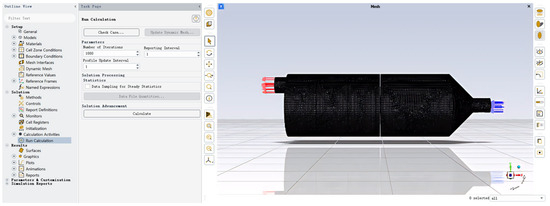
Figure 16.
Flow field simulation calculation diagram.
Finally, the contours of the velocity field, pressure field, and turbulent kinetic energy field of the split-stream rushing muffler were obtained.
- Analysis of velocity field simulation results
From the inlet velocity of 40 m/s flow field velocity contour in Figure 17, it can be seen that the velocity of the gas flow at the inlet was 40 m/s as it entered the cavity. First of all, the gas encountered the obstruction of a cone structure, the velocity of the gas flow decreased, and it reached about 32 m/s. After that, the gas followed the cone structure, splitting into two streams of gas flow from the original stream, and the gas arrived at about the middle portion of the divergent gas hedging unit. When the gas reached the middle part of the split gas hedge unit, the gas entered the inner cavity of the muffler through the rushing holes on the inner wall. Because the size of the square holes was very small, the speed of the gas flow when passing through the square holes was relatively fast, and the maximum speed reached 54 m/s, which generated the phenomenon of jetting. After the airflow reached the inner cavity of the muffler, because the rushing hole was set up symmetrically up and down, two airflows with the same size and opposite direction of velocity met in the center area of the inner part of the split-stream rushing muffler, resulting in a reduction in the internal airflow velocity, which occurred due to the formation of the opposite direction of the split-stream rushing muffler by the two airflows. Afterwards, the airflow entering the inner cavity followed the inlet pipe of the rear section of the muffler, entered the second cavity of the rear section of the muffler, and transitioned from the larger space to the smaller space. This caused an increase in velocity at the inlet pipe of the rear section of the muffler. The rear section of the muffler was divided into three chambers by two perforated plates, all of which were perforated, and there were also holes in the inlet and outlet pipes. In the process of air flow, due to the short cavity, the high-speed air flow met the obstruction of the wall before it could diffuse. The outlet velocity of the muffler was 32 m/s, which represented a decrease in airflow velocity compared to the inlet velocity.
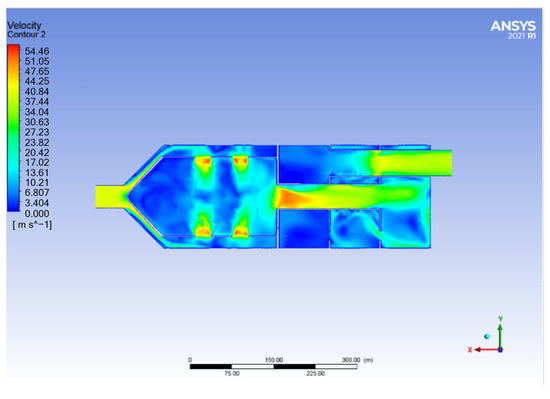
Figure 17.
Velocity contour of flow field with inlet velocity of 40m/s.
- Analysis of pressure field simulation results
Figure 18 shows the pressure contour of the flow field at an inlet flow rate of 40 m/s. The gas entered the muffler from the inlet pipe, and at that time, the pressure was about 4806 Pa and encountered the obstruction of the cone structure, which formed the accumulation of hydrostatic pressure, the pressure became larger, and the value reached about 5213 Pa. After that, the gas was split into two streams along the cone structure and entered the inner cavity of the muffler through the square holes located near the middle of the muffler’s front section. The Pressure Loss was lower than the pressure outside the cavity as a result of the existence of square holes. Due to the existence of the square holes, the gas encountered an obstruction when entering the inner cavity, which generated a certain Pressure Loss, resulting in the pressure inside the cavity being lower than that outside the cavity. After that, the airflow entered the muffler through the inlet pipe at the back of the muffler. From the pressure contour, it could be observed that when the airflow passed through the muffler rear section inlet pipe, square holes, and orifices, the pressure decreased, which was due to the resistance loss caused by the sudden change in the cross-sectional area of the pipe. The Pressure Loss of the split-stream rushing muffler was 4525.41 Pa, while the Pressure Loss of the original muffler was 4673.21 Pa. A numerical comparison showed that the Pressure Loss of the split-stream rushing muffler was lower than that of the original muffler, which indicated that the aerodynamic performance of the split-stream rushing muffler was better than that of the original muffler.
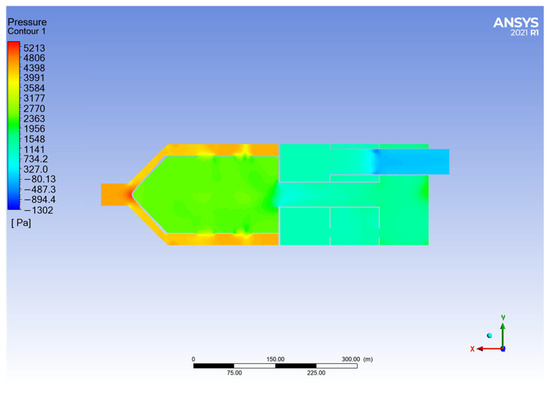
Figure 18.
Pressure contour of flow field with inlet velocity of 40 m/s.
- Analysis of turbulent kinetic energy field simulation results
Turbulent kinetic energy is a measure of the development or decay of turbulence and can be used to evaluate the stability of a flow. At the same time, turbulent kinetic energy can also be used as an important indicator to analyze the magnitude of internal regenerative noise. In fluid mechanics, the calculation and analysis of turbulent kinetic energy is of great significance for the in-depth study of the characteristics and mechanisms of flow.
Figure 19 illustrates the turbulent kinetic energy contour for the inlet flow velocity of 40 m/s. The turbulent kinetic energy in the muffler was mainly distributed in the regions of the counterpoise holes, the connection between the front and rear chambers, and the perforated apertures. The maximum turbulent kinetic energy K was about 72 m2/s2. It could be seen that under the condition of an inlet air velocity of 40 m/s, the muffler, on the whole, had a not-so-large internal turbulence intensity. Thus, the conclusion was drawn that the airflow regeneration noise was not significant.
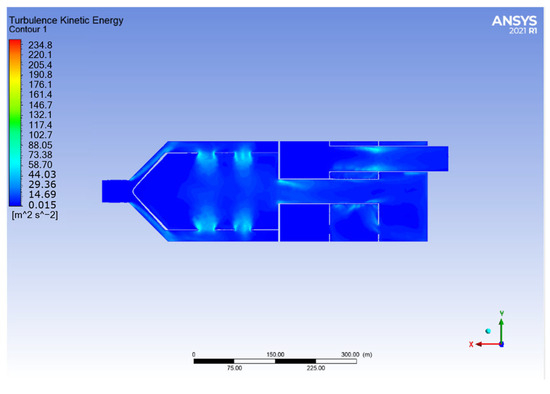
Figure 19.
Turbulence kinetic energy contour of flow field with an inlet velocity of 40m/s.
3.3.2. Aerodynamic Performance Experiment Results and Analysis
The Pressure Loss experiment of the split-stream rushing muffler acrylic model was carried out by using the self-made muffler Pressure Loss experiment bench developed in the earlier stages of the group’s research, and the experiment data were also compared and analyzed with the simulation data. Figure 20 illustrates the glassiness model of the split-stream rushing muffler, while Figure 21 shows the experiment situation of the split-stream rushing muffler Pressure Loss.

Figure 20.
Acrylic model of split-stream rushing muffler.

Figure 21.
Split-stream rushing muffler Pressure Loss experiment.
The results of the split-stream rushing muffler Pressure Loss experiments at an inlet velocity of 40 m/s are shown in Table 4.

Table 4.
Comparison between the experimental and simulated values of muffler outlet velocity.
From Table 4, it could be found that the difference between the test and simulation values of the inlet and outlet velocities of the split-stream rushing muffler was not large, meeting the basic simulation accuracy requirements. The test data and simulation data could better reflect the characteristics of the split-stream rushing muffler, and the data had reference value.
The split-stream rushing muffler Pressure Loss experiment value was compared with the simulation value, as shown in Table 5.

Table 5.
Comparison of split-stream rushing muffler Pressure Loss data with simulation data.
Based on the examination of the experiment data and simulation data concerning the Pressure Loss of the split-stream rushing muffler, it was discernible that the disparity between the two was not substantial, with the relative error being approximately 8% or lower. With respect to the generation of relative errors, potential influencing factors include the integrity of the seal of the test equipment, as well as the precision and accuracy of the test instrumentation. The split-stream rushing muffler was efficacious in attenuating the Pressure Loss, thereby gaining control over the engine exhaust back pressure. The reduction in exhaust back pressure was conducive to the enhancement of engine performance and fuel economy. Additionally, the split-stream rushing muffler unit possessed the characteristic of decelerating the airflow velocity, and thus, to a certain extent, could mitigate the propensity of the muffler Pressure Loss to escalate in response to an increment in the inlet airflow velocity.
4. Discussion
Orthogonal tests were implemented to ascertain the optimal combination of structural parameters for the split-stream rushing muffler. LMS. Virtual. Lab and Fluent were utilized to simulate the Transmission Loss and fluid dynamics of the muffler. Through modifying the structural parameters, namely the perforation aperture of the perforated pipe, the perforation rate of the perforated pipe, and the perforation rate of the perforated plate, the acoustic and aerodynamic performances of the muffler exhibited varying degrees of alterations. Orthogonal tests were deployed to identify the main factors influencing the sequence, with the perforation rate of the perforated plate being the most significant, followed by the perforation aperture of the perforated pipe, and then the perforation rate of the perforated pipe. Upon analyzing the outcomes of the orthogonal test, the optimal combination of the structural parameters was established as a perforation aperture of 8 mm for the perforated pipe, a perforation rate of 10% for the perforated pipe, and a perforation rate of 15% for the perforated plate.
By comparing the simulation results of the Transmission Loss of the split-stream rushing muffler and the original muffler, it was found that in the main muffling frequency band from 300 Hz to 1000 Hz, the average Transmission Loss of the split-stream rushing muffler was 41.91 dB, and the average Transmission Loss of the original muffler was 34.13 dB, whereas the average Transmission Loss of the split-stream rushing muffler was 7.78 dB higher than the average Transmission Loss of the original muffler. At the same time, the transfer loss in the main muffling frequency band was summed and calculated, and it was found that the transfer loss of the split-stream rushing muffler was 22.91% higher than that of the original muffler. Secondly, in the high-frequency region after 1000 Hz, the Transmission Loss of the split-stream rushing muffler was higher than that of the original muffler. In terms of aerodynamic performance, the Pressure Loss of the split-stream rushing muffler was smaller than that of the original muffler.
Through the insertion loss test and test bench Pressure Loss test of split-stream rushing muffler, it could be seen that the muffling performance of split-stream rushing muffler was better, and the suppression effect was obvious for the main muffling frequency band and high-frequency noise. These results provide valuable references for the performance optimization of mufflers. However, it should be noted that these conclusions are obtained through simulation software under ideal conditions. The software was unable to simulate real-world scenarios, and its effectiveness in practical applications might have been somewhat limited. It is necessary to consider numerous complex factors present in the real world, such as ambient temperature, humidity, wind speed, and geographical location. Future research could further enhance the evaluation and optimization of muffler performance by improving field test conditions and other methods, thereby providing more accurate and reliable data support for practical applications.
The acoustic performance of mufflers improved as the temperature rose, and gasoline engines typically had relatively high exhaust temperatures. Due to technological limitations, this paper did not consider the influence of temperature on muffler performance, which could be taken into account in subsequent research.
Author Contributions
Conceptualization, S.A. and H.Y.; methodology, Y.L.; software, M.J.; validation, Y.M., H.S. and J.X.; formal analysis, Y.L.; investigation, H.Y.; resources, M.J.; data curation, S.A.; writing—original draft preparation, S.A.; writing—review and editing, H.Y.; visualization, J.X.; supervision, H.S. and W.J.; project administration, Y.M.; funding acquisition, J.X. and W.J. All authors have read and agreed to the published version of the manuscript.
Funding
This research was funded by the National Natural Science Foundation of Inner Mongolia Region (2024MS05039), the “Grassland Talents” Industrial Innovation Talent Team Project of Inner Mongolia Region (2014 No. 27), Inner Mongolia Engineering Research Center for Intelligence Facilities in Prataculture and Livestock Breeding, the Ministry of Agriculture and Rural Affairs-Research Base for Full Mechanization of Dairy Farming Engineering and Equipment, Inner Mongolia Natural Science Foundation of China (2023LHMS05045), Inner Mongolia Autonomous Region Science and Technology Program (2022YFXZ0028), the Inner Mongolia Natural Science Foundation (2023MS05022), and Basic Research Funds for Directly Affiliated Universities in Inner Mongolia (BR230155).
Institutional Review Board Statement
Not applicable.
Informed Consent Statement
Not applicable.
Data Availability Statement
The original contributions presented in this study are included in the article. Further inquiries can be directed to the corresponding author.
Conflicts of Interest
The authors declare no conflicts of interest.
References
- Sanok, S.; Berger, M.; Muller, U.; Schmid, M.; Weidenfeld, S.; Elmenhorst, E.; Aeschbach, D. Road Traffic Noise Impacts Sleep Continuity in Suburban Residents: Exposure-response Quantification of Noise-Induced Awakenings from Vehicle Pass-Bys at Night. Sci. Total Environ. 2021, 817, 152594. [Google Scholar] [CrossRef] [PubMed]
- Al-Thani, H.; Koc, M.; Isafan, R.J.; Bicer, Y. A Review of the Integrated Renewable Energy Systems for Sustainable Urban Mobility. Sustainability 2022, 14, 10517. [Google Scholar] [CrossRef]
- Mohamed, A.; Paleologos, E.; Howari, F. Noise pollution and its impact on human health and the environment. Pollut. Assess. Sustain. Pract. Appl. Sci. Eng. 2021, 4, 975–1026. [Google Scholar]
- Davis, D.D.; Stokes, G.M.; Moore, D.; Stevens, G.L. Theoretical and experimental investigation of mufflers with comments on engine-exhaust muffler design. Tech. Rep. Arch. Image Libr. 1954, 3, 31–33. [Google Scholar]
- Ji, Z. Muffler Acoustic Theory and Design; Science Press: Beijing, China, 2015; pp. 24–72. [Google Scholar]
- Hujare, P.P.; Mote, V.R.; Mache, A.R.; Hujare, D.P.; Kore, S.S. Analysis for effect of pores on acoustic performance of reactive muffler. Noise Vib. Worldw. 2021, 9, 52. [Google Scholar] [CrossRef]
- Chen, J.; Li, Z.; Huang, W.; Zhong, Y.; Chen, L.; Lu, M.; Chen, Y. Composite muffler based on low-frequency sound absorbing metamaterials. J. Appl. Acoust. 2024, 43, 95–99. [Google Scholar]
- Patil, N.; Chaudhary, S. CFD analysis of exhaust backpressure for four-stroke ci engine. IJRTI 2018, 3, 247–252. [Google Scholar]
- Wang, Z.; Pan, J.; Su, W. Design of Racing Car Muffler in FSAE Based on GT-Power. J. Phys. Conf. Ser. 2021, 1972, 012033. [Google Scholar] [CrossRef]
- Peng, C.; Mao, J.; Feng, J.; Zeng, X.; Li, L. Structure design and simulation analysis of muffler. Automob. Appl. Technol. 2023, 48, 72–78. [Google Scholar]
- Zhang, Y.A.; Wu, P.; Ma, Y.H.; Su, H.; Xue, J. Analysis on acoustic performance and flow field in the split-stream rushing muffler unit. J. Sound Vib. 2018, 430, 185–195. [Google Scholar] [CrossRef]
- Xue, J.; Wu, P.; Su, H.; Zhang, Y.A.; Zhang, H.J. Experimental Research On Comprehensive Performance Of Coupled Muffler Based On Split-Stream Rushing Principle. INMATEH-Agric. Eng. 2020, 62, 29–38. [Google Scholar] [CrossRef]
- Su, H.; Wu, P.; Xue, J.; Zhang, Y.A.; Zhang, H.J. Analysis of flow field characteristics and structure optimization of the split-stream rushing muffler for diesel engine. Noise Control Eng. J. 2020, 68, 101–111. [Google Scholar] [CrossRef]
- Xue, J.; Zhang, Y.A.; Su, H.; Wu, P. Study on the acoustic performance of a coupled muffler for diesel engine. Noise Control Eng. J. 2022, 70, 231–245. [Google Scholar] [CrossRef]
- Li, Z. Automotive Exhaust System Noise and Muffler Design; China Environmental Science Press: Beijing, China, 1991; pp. 10–35. [Google Scholar]
- Guo, R. Acoustic Theory and Application of Mufflers for Automotive Turbocharged air Intake Systems; Tongji University Press: Shanghai, China, 2017; pp. 52–73. [Google Scholar]
- Tang, J.; Liu, Z.; Zhang, K.; Hong, X. Progress in reactive muffler performance research. Constr. Mach. Equip. 2020, 51, 71–76. [Google Scholar]
- Shao, Y.; Wu, P.; Han, B.; Ma, Y.; Zhao, Z. Acoustic characteristics of out-of-phase and split-stream-rushing muffler for diesel engine. Trans. CSICE 2012, 30, 67–71. [Google Scholar]
- Wang, Z.; Su, W.; Wang, S. Ignition and calibration of the KTM 690 single-cylinder engine. Sci. Technol. Innov. 2021, 15, 140–144. [Google Scholar]
- GB/T 33928-2017; Reciprocating Internal Combustion Engines—Measurement Method for Silencers—Sound Power Level of Exhaust Noise and Insertion Loss Using Exhaust Sound Pressure and Power Loss Ratio. National Internal Combustion Engine Standardization Technical Committee: Beijing, China. Available online: https://www.chinesestandard.net/PDF/English.aspx/GBT33928-2017 (accessed on 19 January 2025).
- Li, Y.; Hu, C. Experimental Design and Data Processing; Chemical Industry Press: Beijing, China, 2017; pp. 34–92. [Google Scholar]
- Wang, P. Research on the Influence of Structural Elements on the Aerodynamic Performance and Acoustic Performance of Muffler. Master’s Thesis, Degree-Xihua University, Chengdu, China, 1 June 2021. [Google Scholar]
- Mao, S. Design of Experiment; China Statistics Press: Beijing, China, 2012. [Google Scholar]
- Miao, K. The Numerical Simulation Analysis on Acoustic and Fluid Dynamic Performance of Exhaust Muffler Based on Fluent. Master’s Thesis, Degree-Chang’ an University, Xi’an, China, 6 May 2015. [Google Scholar]
Disclaimer/Publisher’s Note: The statements, opinions and data contained in all publications are solely those of the individual author(s) and contributor(s) and not of MDPI and/or the editor(s). MDPI and/or the editor(s) disclaim responsibility for any injury to people or property resulting from any ideas, methods, instructions or products referred to in the content. |
© 2025 by the authors. Licensee MDPI, Basel, Switzerland. This article is an open access article distributed under the terms and conditions of the Creative Commons Attribution (CC BY) license (https://creativecommons.org/licenses/by/4.0/).